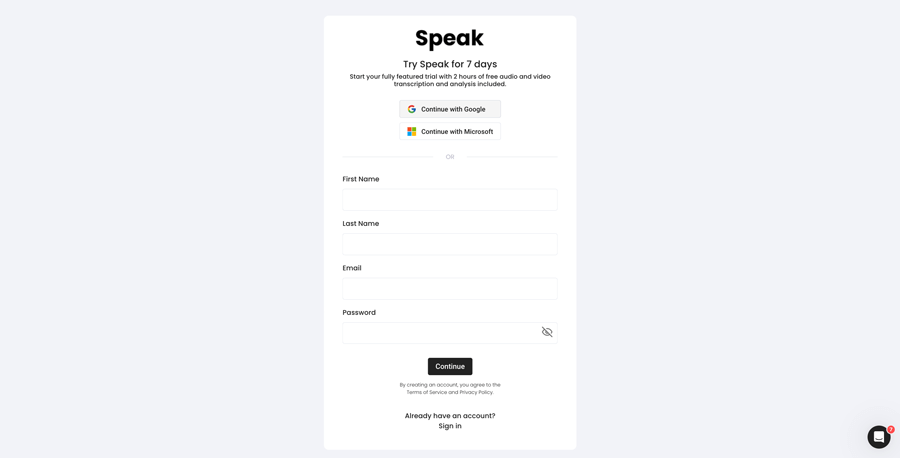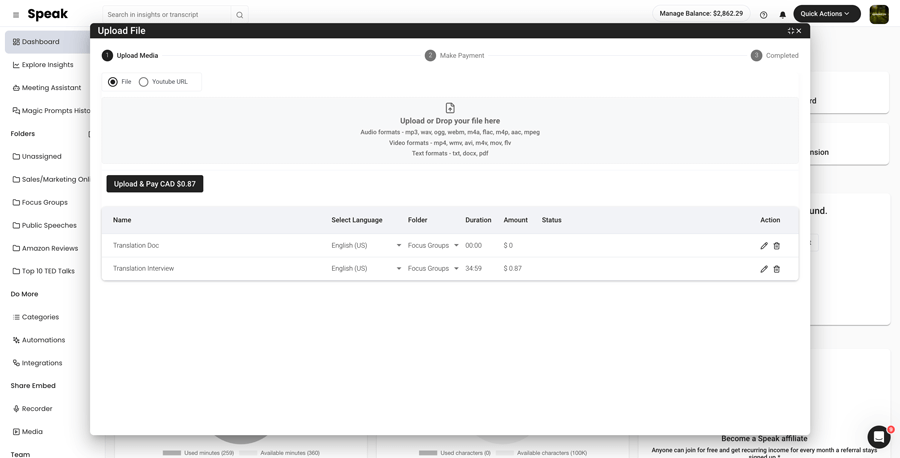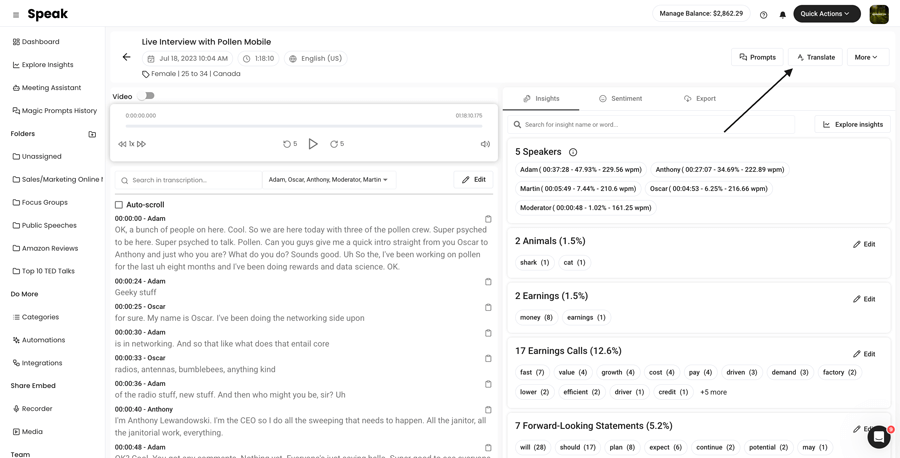How To Translate Latin to English
Translating Latin to English is super simple!

Step 1: Register for Speak
Register for Speak using this link.
Once you register, you can instantly begin translating your Latin to English file(s).

Step 2: Upload Your Latin file(s)
As soon as you log in, you will be redirected to the dashboard.
Once there, you can select the Quick Action "New Upload".
In Speak, you can seamlessly upload, transcribe and translate audio, video and text files all at once!

Step 3: Translate Your Latin file(s) to English
Once the file is uploaded, simply visit your file and select "Translate".
If it is an audio and video file, Speak will ask you if you want to keep the speaker names and timestamps in the translation.
Want to translate many files at once? No problem!
You can view the files you want to automatically translate from Latin to English from the folder level and instantly translate as many files as you need with our artificial intelligence translation in just a few clicks.

Step 4: That's It! View, Analyze, Modify & Export Your New English file(s)
Once the translation is done, you will be alerted and you will see a new document in the same folder your original file is in.
The file will be named the same but with a dash indicating that it is the translated version.
Need support with your Latin translation?
We are always here and happy to help at Speak!
Just send us a message on live chat on the bottom right corner and we will ensure you are set up for success.
Interested in translating Latin or other languages to different languages? View our entire list of supported translation languages here.
Automatic, accurate, instant AI translation from Latin to English is here for you.
Register for Speak using this link and begin translating Latin to English today.
Unlock the Potential: The Power of Translating Latin to English
Imagine unlocking centuries-old manuscripts, enhancing your research, or expanding your business reach by overcoming language barriers. The art of translating Latin to English opens a realm of possibilities. In this comprehensive guide, we explore the unparalleled value brought by AI-driven Latin to English translations, particularly for researchers and businesses. Join us on a journey with Speak AI, where technology meets linguistic heritage, paving the way for incredible discoveries and opportunities.
Why Translate Latin to English?
In a world where English is the lingua franca for business and academia, the ability to translate Latin—a language rich in history, knowledge, and scientific lexicon—into English is invaluable. Whether it's accessing ancient texts, legal documents, or enhancing linguistic research, the benefits are profound.
Gateway to Ancient Wisdom
Latin, the venerable language of the Romans, serves as a key to unlocking vast stores of historical, philosophical, and scientific knowledge. Through translation, we can bring these treasures into the modern era, making them accessible for education, research, and enjoyment.
Empowering Researchers and Academics
For scholars delving into history, literature, or theology, the accuracy of translating Latin texts is paramount. AI-powered translation tools like Speak AI not only expedite the process but also ensure a level of precision unmatched by traditional methods.
Enhancing Business Operations
In the realm of legal, pharmaceutical, and scientific industries, many terminologies have Latin origins. Automatic translation tools bridge the language gap, facilitating international partnerships, and simplifying complex terminologies into understandable English.
The Speak AI Advantage in Latin to English Translation
Speak AI is at the forefront of revolutionizing Latin to English translations. Integrating advanced NLP, large language models, and AI, Speak AI offers a comprehensive solution for translating text, audio, and video content efficiently and accurately.
Exceptional Accuracy and Speed
With Speak AI, expect nothing less than translations that honor the context and nuances of the original Latin text. Our AI Meeting Assistant enhances real-time communication by providing immediate, accurate translations during multinational meetings on platforms like Microsoft Teams, Zoom, Google Meet, and Webex.
Cost-Effective Solutions
Automatic translations significantly reduce the need for expensive human translators, offering a cost-effective alternative for businesses and researchers. This investment in technology leads to notable time and resource savings, driving down operational costs while maintaining high-quality outputs.
Data Visualization and Insights
Speak AI doesn’t just translate; it provides valuable insights. By visualizing data trends in translated content, users gain a deeper understanding of their research or business landscapes, empowering decision-making with actionable intelligence.
Latin and English: Bridging Two Worlds
Translating from Latin to English is not merely about changing words from one language to another; it's about connecting two distinct worlds, each with its rich history and cultural significance.
Global Popularity and Relevance
Latin, though considered a "dead" language, lives on through English, the world’s primary lingua franca. English has over 1.5 billion speakers globally, with a significant presence in academia, science, and business. Meanwhile, Latin, with its undeniable influence on various European languages, remains a fundamental study in classical education and specific professional fields.
Interesting Facts and Shared Roots
Latin and English share a complex relationship. Latin has contributed significantly to the English vocabulary, especially in areas like law, medicine, and science. Fun facts include the presence of Latin phrases in everyday English conversations and the Latin roots of approximately 60% of the English language, particularly in scientific and technical vocabulary.
Differences and Similarities
Despite their intertwined histories, Latin and English vary greatly in grammar and syntax. Latin's reliance on inflection and English's use of word order for meaning represent one of their fundamental differences. However, their shared lexical roots highlight a deep connection, enabling a smoother translation process, especially with the aid of AI technologies.
Conclusion: The Future of Latin to English Translation
As technology evolves, so does the ease and accuracy of translating Latin to English. Speak AI is at the pinnacle of this evolution, offering tools that not only translate but also provide insights and enhance understanding across languages.
Whether you’re a researcher aiming to uncover historical truths, a business looking to globalize, or simply a language enthusiast, the ability to translate Latin to English efficiently opens up a universe of possibilities. Embrace the future of translation with Speak AI, and embark on a journey of discovery, innovation, and global connection.
Discover Speak AI Today
Join over 150,000 satisfied users and experience the Speak AI difference. With a 4.9 rating on G2, our AI Meeting Assistant, and groundbreaking translation technologies, your journey into the Latin to English translation will be nothing short of revolutionary. Dive into the world of automatic translation and let Speak AI be your guide to a newfound understanding and global collaboration.
Get in Touch
Ready to explore the possibilities? Visit our website, sign up for our services, and transform your world with Speak AI's Latin to English translation tools today.
---
FAQs
What locations are Latin and English popular?
Latin, while not widely spoken, has historical significance across Europe, serving as the foundational language for many European languages. It is particularly relevant in the Vatican, where it remains the official language. English, on the other hand, is a global language, with over 1.5 billion speakers worldwide, prominently the UK, USA, Canada, Australia, and parts of Africa and Asia.
What are some fun facts about Latin and English?
One interesting fact is that Latin phrases such as "E pluribus unum" (Out of many, one) and "Carpe diem" (Seize the day) are commonly used in English. Another is that many English words have Latin roots, evolving over centuries to form modern English.
What are the differences and similarities between Latin and English?
The main difference lies in grammatical structure—Latin is highly inflected, meaning the form of words changes to express different grammatical cases. English relies more on word order and prepositions. Yet, the vast number of Latin-derived words in English points to a deep lexical similarity, facilitating the translation process.
Translate Latin To These Other Supported Languages:
- Translate Latin-to-Afrikaans
- Translate Latin-to-Albanian
- Translate Latin-to-Amharic
- Translate Latin-to-Arabic (Egypt)
- Translate Latin-to-Arabic (Iraq)
- Translate Latin-to-Arabic (Israel)
- Translate Latin-to-Arabic (Jordan)
- Translate Latin-to-Arabic (Kuwait)
- Translate Latin-to-Arabic (Lebanon)
- Translate Latin-to-Arabic (Oman)
- Translate Latin-to-Arabic (Palestinian Authority)
- Translate Latin-to-Arabic (Qatar)
- Translate Latin-to-Arabic (Saudi Arabia)
- Translate Latin-to-Arabic (Syrian Arab Republic)
- Translate Latin-to-Arabic (United Arab Emirates)
- Translate Latin-to-Arabic Modern Standard (Bahrain)
- Translate Latin-to-Armenian
- Translate Latin-to-Assamese
- Translate Latin-to-Aymara
- Translate Latin-to-Azerbaijani
- Translate Latin-to-Bambara
- Translate Latin-to-Basque
- Translate Latin-to-Belarusian
- Translate Latin-to-Bengali
- Translate Latin-to-Bhojpuri
- Translate Latin-to-Bosnian
- Translate Latin-to-Bulgarian
- Translate Latin-to-Catalan
- Translate Latin-to-Cebuano
- Translate Latin-to-Chinese (Simplified)
- Translate Latin-to-Chinese (Traditional)
- Translate Latin-to-Corsican
- Translate Latin-to-Croatian
- Translate Latin-to-Czech
- Translate Latin-to-Danish
- Translate Latin-to-Dari
- Translate Latin-to-Dhivehi
- Translate Latin-to-Dogri
- Translate Latin-to-Dutch
- Translate Latin-to-English
- Translate Latin-to-English (Australia)
- Translate Latin-to-English (Indian)
- Translate Latin-to-English (Irish)
- Translate Latin-to-English (New Zealand)
- Translate Latin-to-English (Scottish)
- Translate Latin-to-English (South African)
- Translate Latin-to-English (United Kingdom)
- Translate Latin-to-English (United States)
- Translate Latin-to-Esperanto
- Translate Latin-to-Estonian
- Translate Latin-to-Ewe
- Translate Latin-to-Farsi (Persian)
- Translate Latin-to-Filipino Tagalog
- Translate Latin-to-Finnish
- Translate Latin-to-French
- Translate Latin-to-French (Canada)
- Translate Latin-to-Frisian
- Translate Latin-to-Galician
- Translate Latin-to-Georgian
- Translate Latin-to-German
- Translate Latin-to-German (Swiss)
- Translate Latin-to-Greek
- Translate Latin-to-Guarani
- Translate Latin-to-Gujarati
- Translate Latin-to-Haitian Creole
- Translate Latin-to-Hausa
- Translate Latin-to-Hawaiian
- Translate Latin-to-Hebrew
- Translate Latin-to-Hindi
- Translate Latin-to-Hmong
- Translate Latin-to-Hungarian
- Translate Latin-to-Icelandic
- Translate Latin-to-Igbo
- Translate Latin-to-Ilocano
- Translate Latin-to-Indonesian
- Translate Latin-to-Irish
- Translate Latin-to-Italian
- Translate Latin-to-Japanese
- Translate Latin-to-Javanese
- Translate Latin-to-Kannada
- Translate Latin-to-Kazakh
- Translate Latin-to-Khmer
- Translate Latin-to-Kinyarwanda
- Translate Latin-to-Konkani
- Translate Latin-to-Korean
- Translate Latin-to-Krio
- Translate Latin-to-Kurdish
- Translate Latin-to-Kurdish (Sorani)
- Translate Latin-to-Kyrgyz
- Translate Latin-to-Lao
- Translate Latin-to-Latin
- Translate Latin-to-Latvian
- Translate Latin-to-Lingala
- Translate Latin-to-Lithuanian
- Translate Latin-to-Luganda
- Translate Latin-to-Luxembourgish
- Translate Latin-to-Macedonian
- Translate Latin-to-Maithili
- Translate Latin-to-Malagasy
- Translate Latin-to-Malay
- Translate Latin-to-Malayalam
- Translate Latin-to-Maltese
- Translate Latin-to-Maori
- Translate Latin-to-Marathi
- Translate Latin-to-Meiteilon (Manipuri)
- Translate Latin-to-Mizo
- Translate Latin-to-Mongolian
- Translate Latin-to-Myanmar (Burmese)
- Translate Latin-to-Nepali
- Translate Latin-to-Norwegian
- Translate Latin-to-Nyanja (Chichewa)
- Translate Latin-to-Odia (Oriya)
- Translate Latin-to-Oromo
- Translate Latin-to-Pashto
- Translate Latin-to-Persian
- Translate Latin-to-Polish
- Translate Latin-to-Portuguese
- Translate Latin-to-Portuguese (Brazilian)
- Translate Latin-to-Portuguese (Portugal)
- Translate Latin-to-Punjabi
- Translate Latin-to-Quechua
- Translate Latin-to-Romanian
- Translate Latin-to-Russian
- Translate Latin-to-Samoan
- Translate Latin-to-Sanskrit
- Translate Latin-to-Scots Gaelic
- Translate Latin-to-Sepedi
- Translate Latin-to-Serbian
- Translate Latin-to-Sesotho
- Translate Latin-to-Shona
- Translate Latin-to-Sindhi
- Translate Latin-to-Sinhala
- Translate Latin-to-Sinhala (Sinhalese)
- Translate Latin-to-Slovak
- Translate Latin-to-Slovenian
- Translate Latin-to-Somali
- Translate Latin-to-Spanish
- Translate Latin-to-Spanish (Mexico)
- Translate Latin-to-Sundanese
- Translate Latin-to-Swahili
- Translate Latin-to-Swedish
- Translate Latin-to-Tajik
- Translate Latin-to-Tamil
- Translate Latin-to-Tatar
- Translate Latin-to-Telugu
- Translate Latin-to-Thai
- Translate Latin-to-Tigrinya
- Translate Latin-to-Tsonga
- Translate Latin-to-Turkish
- Translate Latin-to-Turkmen
- Translate Latin-to-Twi (Akan)
- Translate Latin-to-Ukrainian
- Translate Latin-to-Urdu
- Translate Latin-to-Uyghur
- Translate Latin-to-Uzbek
- Translate Latin-to-Vietnamese
- Translate Latin-to-Welsh
- Translate Latin-to-Xhosa
- Translate Latin-to-Yiddish
- Translate Latin-to-Yoruba
- Translate Latin-to-Zulu



